Punkraves in pubs, forests, factories and clubs — nearing a decade-long run, PÉNZ debuts their new mixtape
Published May, 2024
by Easterndaze
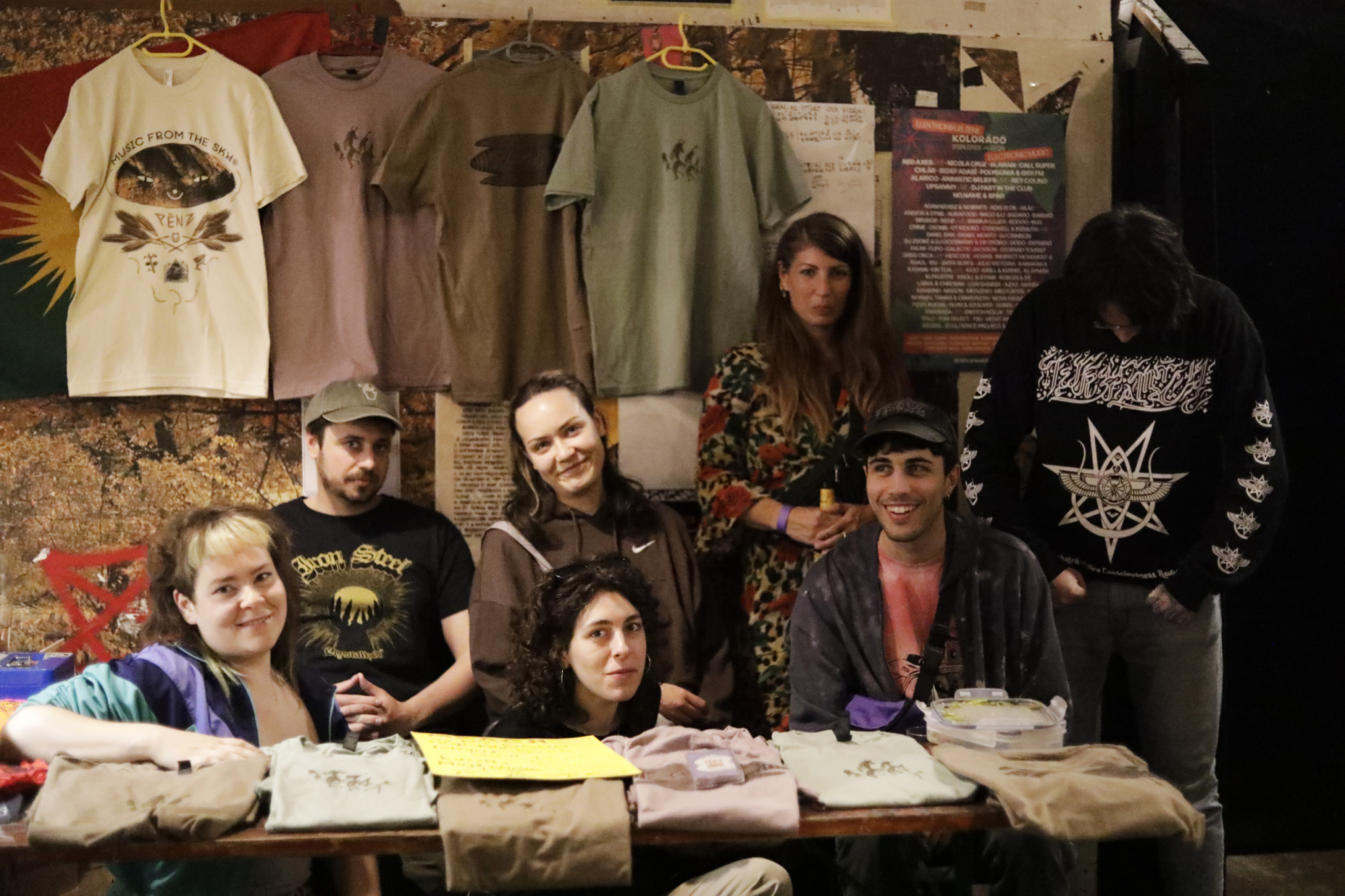
The PÉNZ collective coined (invented?) a trademark sound and vibe within the Budapest nightlife scene. Considering that they’ve been active for almost a decade, perhaps it’s not too much of a stretch to discuss their “life’s work”. I’m not sure whether the term “punkrave” even exists, but it seems fitting for PÉNZ, even some members of the collective will use it to describe themselves in certain contexts (e.g. at punk hub Kripta x PÉNZ parties).
On the 3rd of May 2024, PÉNZ released a new mixtape that showcases how well they’ve been able to keep up their critical, raw and authentic musichead bearings. This article is an attempt at understanding the PÉNZ formula through this new release – one that is almost Heisenbergian in its shape-shifting somewhere in the techno-amen-rave-hardcore-dubstep-bass-art-club-activist polygon. All photos were taken by Krisztina Götz at the Bazi Nagy Kazi Comp Release party.
The first time I saw PÉNZ was back in 2015, right after I moved back to Budapest from Berlin. DJ Köd began his set at Gólya (in their old building on Bókay Street) under cheap green party lasers, balancing a giant grilled sandwich in his hands. This image stuck with me ever since as an ars poetica of PÉNZ, and felt very powerful both musically and aesthetically – I’d just spent 10 years traveling around the world, I was looking for the coolest stuff happening at home.
In short, PÉNZ is a collective of DJs and producers who throw parties. They’re best known for their Erdei rave series – these were “techno parties” that took place on the outskirts of Budapest throughout the night, with a small but decent enough sound system. After the first few events, a solid 300-400 people began attending these parties, the details of which were spread mainly through private Facebook events. Their popularity was fuelled by a type of energy generated by the scene, the community and the music that’s hard to put into words. It was the ultimate rave experience, a musical cocktail of live acts, DJs, and various different genres all crammed into one night.
Musically speaking, PÉNZ came up with a way to mix genres typically originating from the UK with freetekno elements on top of a breakbeat base. They did this all in a way that break (e.g. a quick amen or two) wasn’t just included as a trendy add-on – the more or less homogeneous bass or even dubstep sets were constant, essential ingredients of PÉNZ parties. So much so, that in the (faster) bass scene, PÉNZ DJs were the ones playing the most obscure music out there, and this kind of digger mentality became a PÉNZ staple.
Aesthetically speaking, PÉNZ is lo-fi, or, to misuse the term deliberately: “punk” – although, for example, the lead singer of hardcore punk band Norms recently explicitly opposed the use of the word punk as an adjective that reaches past its original, music-focused meaning during a Kripta x Lahmacun radio panel discussion. Interestingly, there happens to be an overlap between the members of Norms and PÉNZ too, which could be a simple coincidence, but I think it’s the manifestation of a phenomenon that’s pretty common. In no way could it ever be said that all ravers are punks, even in relation to the ravers and punks of Kripta and PÉNZ – and that all punks would be ravers rings even less true – but empirically speaking it seems likely that their views on the world are similar in a lot of ways, and in some fundamental aspect, about music, too.
Other key PÉNZ features are its persona and art, which are probably an outcome of the internal “lobbying” (or the talent, more likely) of some PÉNZ members, rather than of some consensual concept. Anyone who follows PÉNZ events and social media trends will be familiar with the street literature-esque language through which PÉNZ speaks to its followers – again, slightly similar to the voice of Klaudia Kriptai (imaginary resident and PR persona of punk lair Kripta). The other feature is the imagery, which – after comparing their tone to a strand of literature, I might go ahead and call art, and which is often almost “too beautiful” for PÉNZ; like an elemental force that can’t be forced behind pixelated WordArt smileys, and which encompasses so much more than the routine creations of a bunch of art students. There’s serious talent here, which adds a wonderful twist to the already very complex PÉNZ phenomenon.
(Fun fact: PÉNZ also has a website.)
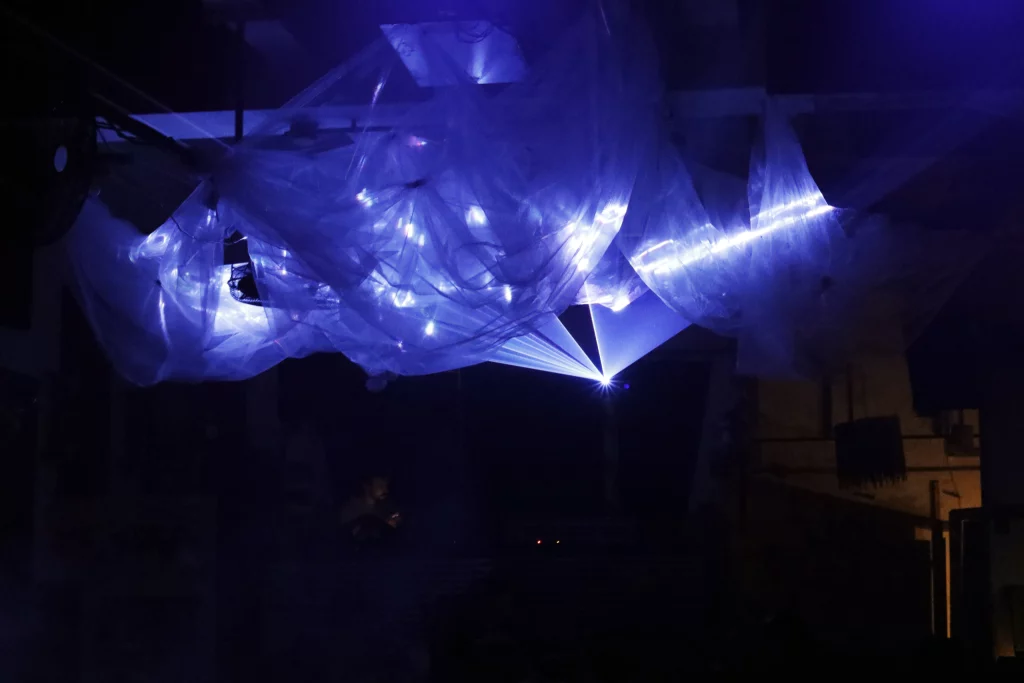
BAZI NAGY KAZI – COMP RELEASE PARTY decor
In the last few years, PÉNZ has gone through a bit of a transformation: they’ve invited well-known acts from abroad several times, organised parties at various indoor venues (their event series at Gólya and Kripta are still running), and they’ve even organised a 2-day festival. All the while, their members have gone through a lot, but are essentially still the same crew as they were in the beginning except for the odd switch in status or newly joining member.
THE TAPE
So, after about a decade of the PÉNZ operation, they put out this mixtape. They claim to have been sitting on it for a while now, and some of the content has been uploaded here and there, but it’s still interesting to see how this rebellious brigade envisions the compilation format – aside from the digital release on Bandcamp, the fact that they released this on a cassette makes for the perfect PÉNZ souvenir among their relatively rare merch releases. As for the tracklist, we’re blessed with several tracks from OG PÉNZ producers (DJ Köd, Alley Catss, DJ Frontin), newly composed additions (Benzin, Mystic Voip), a track each from some older members (Afterstef and DJ Zsaru), some of them under a new or different name (Neverballer, ÄGYBASZARÁS), relatively new members (Simatöcs), and a resident guest (Saboteur). The songs are tied together through ambient transitions exclusive to the tape that seem to resemble the style of Majd nálatok; in this section, I’d especially like to highlight the Lilla Vincze based ‘Maradunk a Duna partján’ insert, which is a very true interpretation of what ambient is.
Those with two (or in the case of one of them, three) tracks on the tape are three of the best DJ-producers in this country (and, in my humble-yet-biased opinion, the world). It’s almost touching to see how they’ve found and refined their sound over the years.
DJ Köd has become a guru of bass music and drum programming; ‘3AM‘ is an ethereal bass/break anthem, one of the most powerful tracks I’ve ever heard from him. ‘Jancsiszög‘ is superb footwork and – although we’ve known it for a long time – serves as a great reminder that there’s more to this originally very non-European genre than the Polish and Serbian (and I don’t know where else) scene. The third track, ‘Rönk‘ is a slow paced dub-sub-bass monster. If I was a sync agent, I’d probably submit it to the soundtrack of the new Dragon Ball movie.
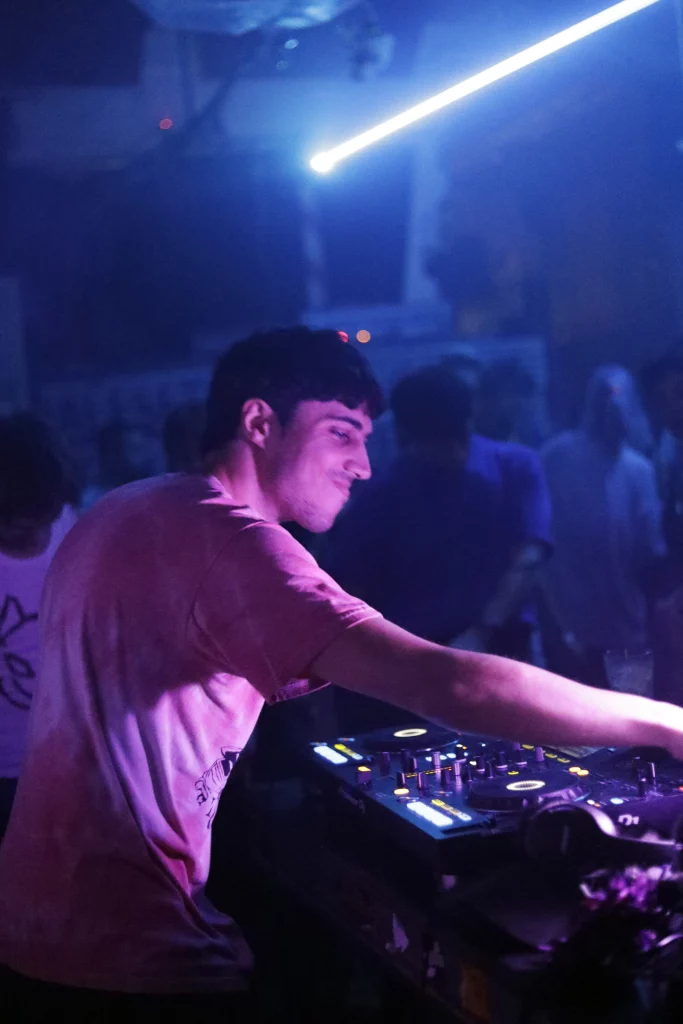
DJ Köd
Samples make up an entirely separate chapter of this tape. DJ Frontin, for starters, is a master of building humongous rave hits from the most random samples. ‘Töltény’ is based on a Tibbah tune, which he turns into a multi-layered madness – an instant hit. ‘Balkan Ya Neck‘ is built on a Busta Rhymes sample, and with its over-pitching of the original, its not only ironic, but a perfect new musical output. This mix is a very special mash-up of original and selected tracks – a 10/10 manifestation of the world of Frontin.
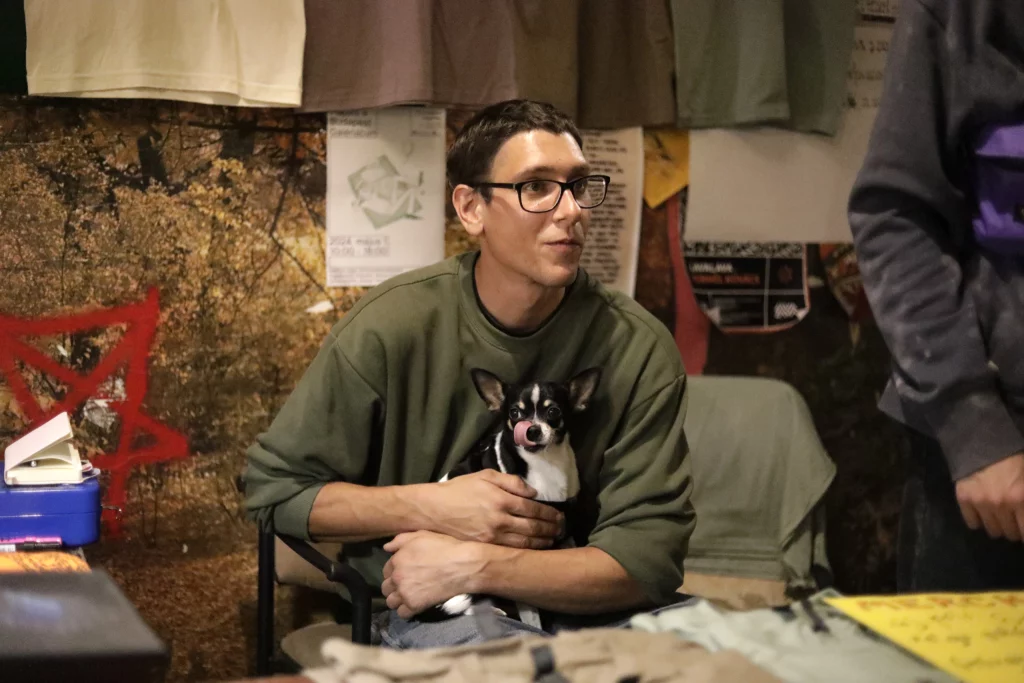
DJ Frontin
DJ Zsaru’s dark dance track (‘Gutter Tech‘) is a wholly different experience. The vocals are strong even without the sample, but with the dub added on from a live performance of tech activist/metal-core band Creation is Crucifixion, this will be a track to write home about, too.
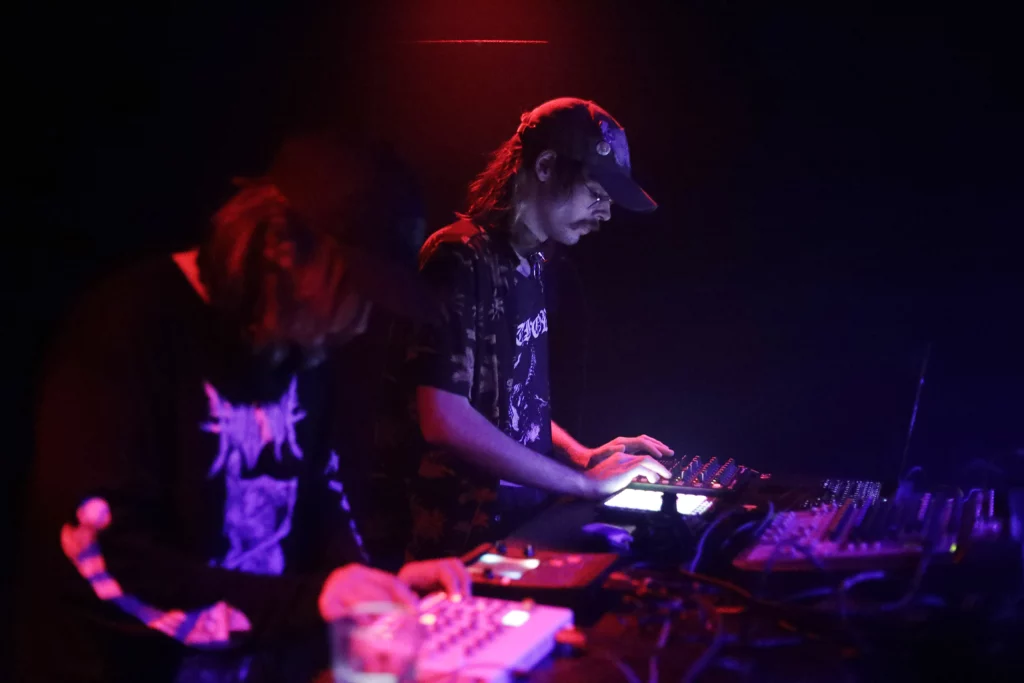
DJ Zsaru & Tumorboy
‘Spiral Obsession‘ is possibly the first ever production of Mystic Voip sampled from an Uzumaki manga adaptation, and is so subtle and (pseudo-)innocent that it almost completely distracts (perhaps due to the claps) the listener from its hard techno base. (After a fair amount of listens, I’ve come to the conclusion that if PÉNZ were to ever make house music, this is what it would sound like).
Alley Catss is a PÉNZ member who makes and releases music under many different pseudonyms and labels alongside his own. ‘toenrl‘ starts off with cleaner and more peaceful sound than what I’m used to from him (with wonderful synth themes) but things get pretty messed up by the end of the track. Contrary to this, ‘jyTLS‘ is a rather trademark Alley Catss sound for me: a grinding dance in digital-dirt, a rave dystopia mixed with hardcore and an infinite stream of ideas.
‘an ambiguous report about the end of the world‘ by Neverballer (aka dj pici cigi) is a track title that seems unusually practical aside from the fact that it’s entirely misleading. The song sounds like a messed up rave-break German soap opera OST. I don’t think he’s ever put out anything that sounds this optimistic.
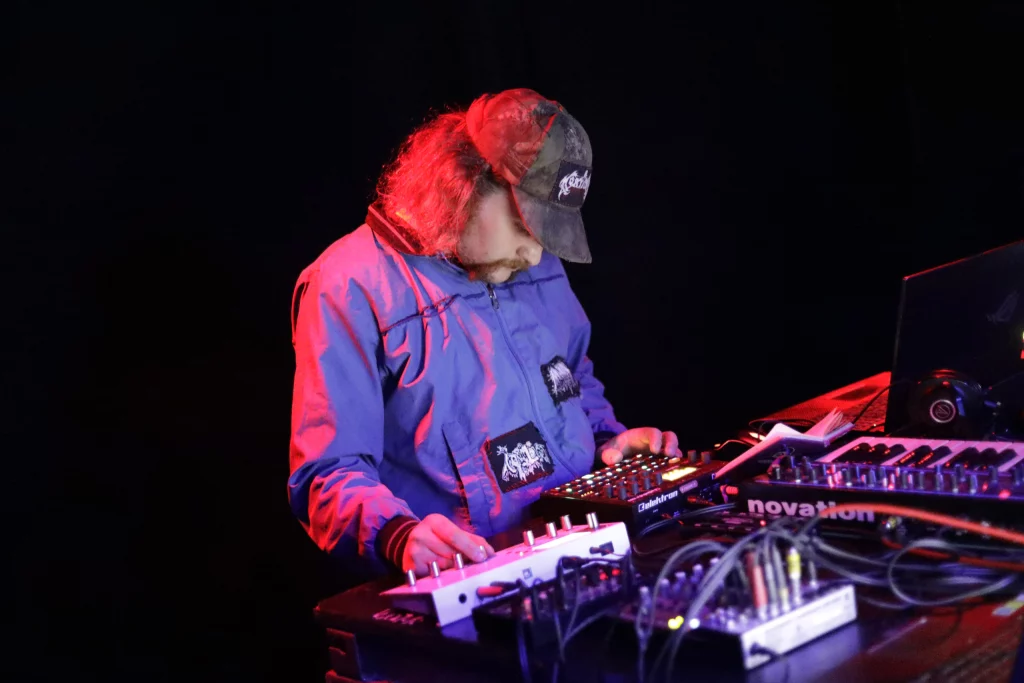
Neverballer
There’s also a guest feature from Saboteur on the tape, which, judging by its title, is an ode to the “typical country disco deodorant“. Saboteur is none other than kidwar by the way, only instead of a live code setup he’s using Ableton, and after hearing ‘Malizia Uomo‘, I can say that it’s no wonder they get on well with the PÉNZ crew.
Experimenting as a new producer is best done at a beach. ‘Beachvibe’ byrock-hard Benzin (formerly MZ/X) in a liquid mood and export-fueled Ableton sprint is the perfect sunrise track – (a backdrop that’s probably easier to organise than the beach, although I think PÉNZ might have organised beach raves before at some Eastern techno festivals).
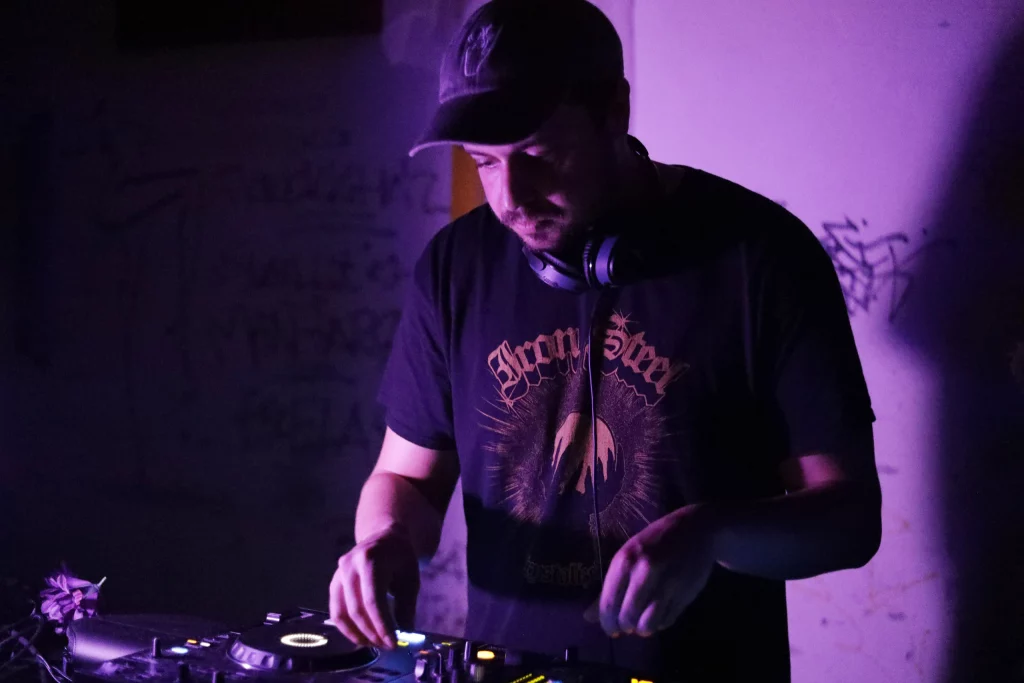
Benzin
And finally, two quotes.
“I don’t think a Simatöcs style exists. No two live shows have ever been the same. All the recordings were made during random live streams at home. The style and tempo is always the intersection of my mental state and sampler bank at that particular time. I like schranz, acid, hardcore and jungle, and can’t decide between them of course, which is why they’re usually all playing at the same time. That doesn’t mean you always have to go berserk! It’s just that the track on this tape was recorded on quite a chaotic day for me.” – I had the pleasure of speaking to Simatöcs about the track called ‘templomi trutyipisztoly’.
“that’s me again
me again
no it’s not
all over the place
ain’t enough
where’s the brake
where’s the end
ain’t the goal”
The above is a short extract from the text of ‘BORDERLINE‘ by DJ Csipsz, through whom PÉNZ has been able to add MC-ing to their genre-portfolio. From rave punk, to rave MC-ing – a known phenomenon in the jungle community, but here, it means something very different. A risky idea that just so happened to work out for PÉNZ. This is largely due to the lyrics and energy of DJ Csipsz, which almost results in a kind of anti-genre – and, come to think of it, this ironic-satirical approach is a significant characteristic of the whole PÉNZ universe, despite them loosening the irony over the years and embodying their own format with conviction. Anyway – ‘ÄGYBASZARÁS’ is a joint project between DJ Csipsz (lyrics & vocals) and B. “savfiú” M. (music & instruments).
And finally, the tape concludes with a joint jubilant jam á la PÉNZ.
(I was in Lyon last week at the Nuits Sonores festival, which I probably won’t be writing much of a review about, except for the fact that they should invite PÉNZ to curate one of their stages. There was a lot of talk in the festival’s programme about futurism, asking musicians (like Abadir, IBAAKU, or Marina Herlop) how they think “futuristic” sound could be made. I’m not sure if one big festival or those who are existentially heavily dependent on it (like the artists listed above) have a chance of doing this, but in any case, if I were to try and apply musical futurism to rave culture, I think PÉNZ has successfully revolutionised the rave recipe.)
Originally written by @gammaw for MMN Mag. Translated from Hungarian by Gabriella Gál.
This article is brought to you as part of the EM GUIDE project – an initiative dedicated to empowering independent music magazines and strengthen the underground music scene in Europe. Read more about the project at emgui.de.
Funded by the European Union. Views and opinions expressed are however those of the author(s) only and do not necessarily reflect those of the European Union or the European Education and Culture Executive Agency (EACEA). Neither the European Union nor EACEA can be held responsible for them.